June 2019 – Volume 21, Issue 5

Scandinavia 2019 Travelogue
Off on a trip: “Scandinavia 2019!” Core reason: graduation. Headed to the three Scandinavian countries: Norway, Sweden, and Denmark. Four hours late out of LAX, our European connection was also lost. Eventually made it through Copenhagen to Bergen, Norway and in jet-lagged delirium, I learned something new: Did you know that Greenland Airlines’ planes are solid red?
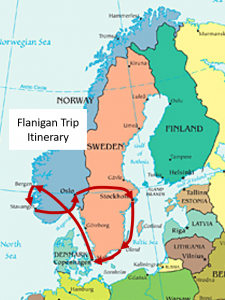
The Fjords of Norway
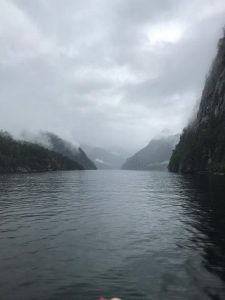 Bergen is the gateway to the fjords! It’s also Norway’s second largest city with a population of 270,000, set upon Norway’s rainy west coast. It was founded in the year 1070 and was Norway’s capital until 1299. It’s known as “the city between the seven mountains,” ringed by mountains, it’s tucked in, trapping the clouds. Bergen – also known as “the City of Rain” – gets 88.5 inches of rain a year. While it rains most days, its people are among the world’s happiest. We see organized dancing in the streets.
Bergen is the gateway to the fjords! It’s also Norway’s second largest city with a population of 270,000, set upon Norway’s rainy west coast. It was founded in the year 1070 and was Norway’s capital until 1299. It’s known as “the city between the seven mountains,” ringed by mountains, it’s tucked in, trapping the clouds. Bergen – also known as “the City of Rain” – gets 88.5 inches of rain a year. While it rains most days, its people are among the world’s happiest. We see organized dancing in the streets.
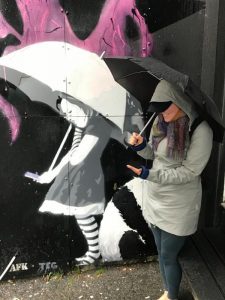
Our penthouse AIRBNB is delightful and enlightening. We wake up among the rooftops of Bergen. It’s raining; we’re prepared. After a hearty breakfast in Bryggen, the heavily photographed Bergen old city, we board a high-speed ferry from Zachariasbryggen Quay in Bergen to Mostraumen, a narrow fjord at the head of the 16-mile Osterfjord in the Hordaland Province. Leaving Bergen, we can see that Bergen to to this day is a trade hub, now known for its shipping and oil industries. Leaving Bergen we see aquaculture.
The word fjord is Norwegian, and has gone international. Travel guides state that Norway’s fjords are like cities in that you have main streets, and side roads, and narrow back alleys. Norway has over 1,000 fjords. They were created by massive glaciation below sea level over the course of 2.5 million years, carved out over a succession of glacial cycles.
The fjord tour is excellent. We leave Bergen and the picture unfolds. We witness the maze of fjords and boats plying this way and that. We pass under the world’s largest floating bridge, the waters far too deep for more conventional bridge footings. We pass a Rolls Royce factory. We meet a young south African architect on board who convinced his firm that he needed to see and feel the buildings of Europe that he’s been studying online.

After an hour of traveling in waters with depths of thousands of feet, the fjord narrows and captain backs way off on the engines. We pass a fisherman wading in the waters and glide quietly through the narrows and a depth of only 10 feet. Then the fjord opens up to a delightful lagoon to the far end of which is the town of Mostraumen, the smallest city in Norway with 380 residents. We glide right up to the waterfront town before the captain shifts the vessel to the side of the gorge, inching up to a dramatic waterfall cascading from the fjord’s cliffs, so that the crew can catch some of its water in a shiny bucket on a long pole. We’re all wet and happy.
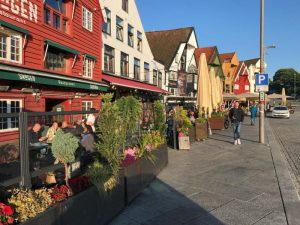
Stavanger
After lunch at the colorful Bergen Fish Market, we take in the sights and smells and tastes. We sample caviars and at a daughter’s spontaneous prompting, whale meat. Normally a vegetarian, she’d already tried moose, and reindeer at one vendor’s stand and thought we ought to give the whale salami a try. When in Rome…. Despite its controversy, Norway and Iceland are the only countries in the world that continue to authorize whaling. Citing its whaling heritage, Norway increased its emphasis in 2018 despite global opposition and despite declining populations.
The next day we take the Floibaden funicular to the top of Floyen, a park about 1,000 feet above Bergen. There we get great views, snap shots, and hike past a herd of most-social goats. There are lots of trails for hikers and bikers; we pass a nature center and walk around a small lake, near mystical in the fog and mist. Later that day we leave Bergen by ferry to Stavanger. It’s a five and a half-hour trip on a much larger ship, showing off Norway’s inland waterways, its industries, and its deeply picturesque landscapes. Our Danish ferry is fueled with LNG.
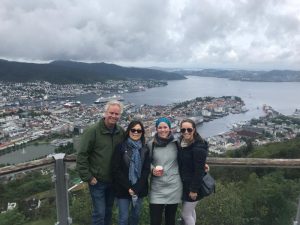
Overlooking Bergen
Europe’s Greenest Capital

Performers in Oslo
SAS Stavanger to Oslo. We’re split up given the cheap seats we bought. My consolation: I meet Elizabet on the plane. She grew up on a farm in Norway and now lives in Stavanger with her family. Her husband works for Equinor, the rebranded state-owned Norwegian oil company formerly known as Statoil. The government and its workers pension fund hold 70% of the company. Elizabet works for an engineers’ union and was headed to Oslo for work for the week. What a great opportunity for insights on life in Norway.
We talk about sustainability. Scandinavia is rich in wind and throughout our trip we’d see lots of it. But Norway still seems to be oil country. That said, Equinor’s new name and brand is meant to symbolize its transformation from 50 years of focus on fossil fuels. Now it claims to be the most carbon efficient oil company and one that is investing in renewables. But I’m told that wind remains controversial in Norway; locals don’t like to see the turbines. And since Norway is already 98% renewably powered with hydroelectricity, many believe the country does not need to mar its landscapes with wind turbines.
We discuss EVs, that were once only found in Oslo. Now they are throughout Norway… a world leader in electric vehicles! Norway boasts the globe’s highest adoption rate of electric vehicles… fully 48% of all new cars in Norway last year were EVs. It’s not hard to imagine this country completely fueled by renewable power given this mix of resources and policy.
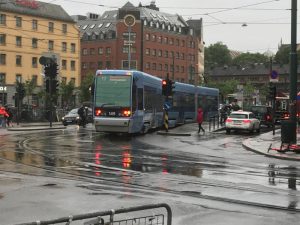
Oslo
Throughout this high-altitude conversation, I peer out the windows, this side to that. It’s a sunny morning. To the north, it’s all white. There are Norway’s mountains and massive glaciers. We talk about downhill and Nordic skiing. To the south, I peer down at a region marked by its countless fjords. Deep cuts in the mountainous region, extending a far as the eye can see. Breathtaking views off this flight path. Elizabet talks about the ski home she and her family recently bought in the mountains; she talks about her children, and her adopted child.
We efficiently train from the airport to Oslo’s downtown. Located in Southern Norway, Oslo is at the head of the Oslofjord. With a population of 658,000, it is a bustling city noted for its high quality of life, and its high cost. In a recent ranking it fell just below Tokyo as the world’s most expensive city. It was also ranked as Europe’s greenest capital in 2018. We’re at an AIBNB right downtown and have a full day to explore. I hadn’t been here in over 20 years. We walk up to the Royal Palace.
Norway clearly has it together: Its 1,650-mile coastline wraps around Sweden. It is rich in natural resources and fisheries. It has one of the highest per capita incomes in the world, topped the “world happiness report” in 2017, first on the OECD’s Better Life Index. Norway has one of the world’s lowest crime rates. Despite its rain, its long winters, these countries have created a high quality of life with environmental care a top priority. Oslo for its part, was ranked Europe’s top green capitol in 2019 for its climate emissions reductions… with progress sited in urban mobility, land-use, nature, and biodiversity.

Viking Ship
The Viking Ship Museum houses the best persevered Viking ships as well as the artifacts from the Oseberg, Gokstad, Tune, and Borre. Two of these “longboats” have been unearthed and restored, making the Viking era quite vivid to me. Tombs of sorts, kings and queens had been buried with their animals and material wealth in these boats.
I’d forgotten how far afield these 9th century the seafaring Norse Vikings travelled… throughout Europe, the Mediterranean and Africa, to Iceland by accident, and of course to Newfoundland. They were known for their advanced sailing and navigational skills, and they’re still the pride of the Norwegians. They “colonized, traded. and raided.”
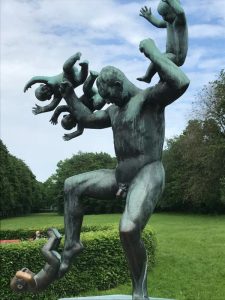
Gustav Vigeland Sculpture
Two buses later and we were at Frogner Park. This is where the statues created by Gustav Vigeland from 1924 – 1943 are located. Fully 212 of his bronze and granite sculptures are on display in the park. It’s the largest single-artist sculpture “installation” in the world and culminates in a monolithic tower with 121 figures desperately reaching for its peak. Vigeland also designed the Nobel Peace Prize medal.
Later it’s drinks with Skye’s Norwegian friends from the University Denver: Peder, Bernard, and Marius. They tell us about life in Oslo… the long winters, and the long nights. They lament the short daylit hours of wind. Now, in summer, it’s just the opposite, the sun setting at 10:00 PM. Peder is training to be a police officer in Oslo, a respected position that’s hard to attain. Tense he was wrapping up his preparation to be examined on a number of technical areas including forensics and case law. These guys are gainful and love Oslo. Skye joins them for a night out on the town.
Celebrating in Karlskrona
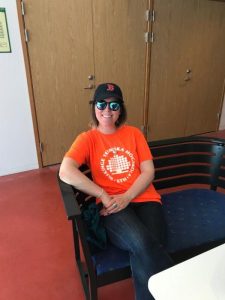
Sierra
The focal point of our trip was Sierra’s graduation from the Blekinge Institute of Technology (BTH). BTH is a Swedish university formed in 1999 with 7,200 students on two campuses. Sierra now holds a Masters of Science in Strategic Leadership Towards Sustainability. She and so many of her classmates said that the program was just what they needed to advance their careers. The BTH “the program advances students’ knowledge, skills, and global networks to build their capacity to be strategic leaders in the co-creation of thriving, sustainable communities.” She and her cohort of classmates found the 10-month program hard-core and transformational. I am happy for her and proud.
Sierra and her cohorts studied at BTH in Karlskrona, a city on the southern cost of Sweden developed as a port for the Swedish Navy. A shipyard there has built military vessels since — and still does. The shipyard is massive and is home to the world’s largest wooden building. Two submarines are being built there right now.
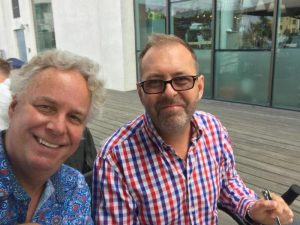
Ted and Johnny
Johnny Gylling runs a company called Good Enterprises 99, or just GE99. He’s a consultant to companies wanting to become good corporate citizens. For ten years he was on the City Council in Karlskrona before heading to Stockholm for eight years in the Parliament. He and his wife Lena were kind enough to give us a four-hour orientation and tour of the city.
We begin with a drive up to the City’s water tower and promontory to get a lay of the land. We then have “fika” at a coffee shop deep within a local innovation center that he helped to establish in a repurposed and defunct porcelain factory. Fika is a big part of every Swedes daily life, a coffee ritual whereby workers sit down for coffee each morning at a prescribed time… taking time to pause, to relate and collaborate. Studies shown that this increases worker moral and creativity and productivity.
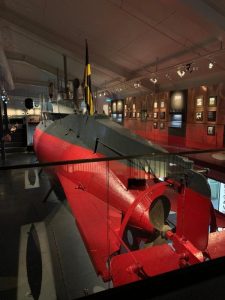
A submarine
Karlskrona is home to a terrific maritime museum that features all sorts of ocean-going vessels. It also houses a wooden boat building center where citizens are given the tools and instruction to build wooden boats. That got my attention. The museum also houses two submarines that visitors can walk – and crawl – through. The larger sub’s periscope pierces the museum’s roof and allows for visitors to peer out, scanning the harbor in stealth and clicking up and down magnifications.
Sierra’s program was a remarkable deep dive into sustainability, and the importance of leadership – marked by effective communications skills. It closed with a graduation ceremony and party on the island of Aspe, a short ferry ride from Karlskrona. I learn that the Swedes treat ferries like bridges… both considered necessary means to get home. Thus they are built and operated at no charge by the government.
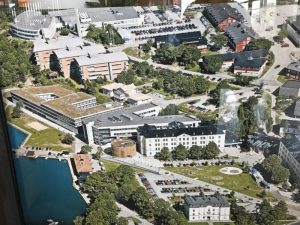
Blekinge Institute of Technology
Sierra’s cohort of 46 students hail from 26 different counties. The program is an immersion in international diplomacy. Sierra was one of only two Americans. Her closest friends were from Peru, Germany, and Finland. They learned so much about each other, working with diversity can be daunting and powerful. The compulsory thesis teams exemplified this.
Sierra was lauded for getting a recycling program instituted on campus, involving the purchase of hundreds of bins. She saw it as a very basic step that simply required some persistence. The program was rigorous; students worked hard and bonded in many ways. As we left the island, after speeches, toasts, and dinner, the sun was finally setting over the calm waters for our idyllic ferry ride “home” to our hotel at the marina.

Copenhagen’s Connection
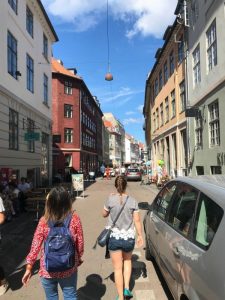
Copenhagen
We train from Karlskona to Copenhagen, passing farm country and wind turbines all along the way. The bridge from Malmo provides great views of the sunny and windy spendor of the sea between Sweden and Denmark. We see offshore wind turbines spinning gaily.
“Welcome home,” texted my brother Billy upon our arrival in Copenhagen. He loves our Danish heritage. And I must admit, I am proud of the Danes. In the green world, Danes are tops!
Stepping outside the train station, it’s hard not to be struck by the bikes. “Biketown” as it is known, has five times as many registered bikes as cars. There are streams of cyclists moving swiftly in Class I (separate) bike lanes. Later we’d hop on Skye’s Donkey Republic bike service and join in the flow, over the new bike bridge at NyHavn, to the famous mermaid, the Royal Palace.
We visit Tivoli and are reminded of a frivolous side of the Danes, and for that matter, all of humanity. A plan to open a ski slope atop the City’s incineration plant, which generates heat to the City’s district heating system, has been held up by environmental review. We visit the Elephant Bar where I’d been many years ago.
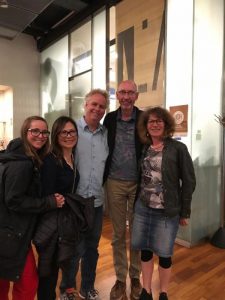
Dinner with Jørgen
Dinner with Jorgen Lund Madsen and his wife. I’d met him in 1993 when I was working for ICLEI and the Urban CO2 Reduction project out of Toronto. The project involved leading cities, creating the first greenhouse gas inventories and climate action plans. My job was to assign emissions coefficients to the power systems in these cities – largely applying Pace Center emissions data – complicated by seasonal generation, consumption patterns, and intra-country power purchases. Copenhagen would later front-load its baseload power plant with an incinerator capable of providing the district heating’s thermal needs in summer when the baseload plant was not needed, and there was excess Swedish nuclear power to provide low-cost electricity.
In those early ICLEI years, Jurgen represented Copenhagen and our travels together included Portland, Oregon and Omiya City, Japan. That was years ago. Now, he’s just back from a month-long bike ride from Copenhagen to Barcelona. I’d never met his wife. Now I hope we are bonded for life.
Jorgen has shifted duties. He works for the Copenhagen Water Department, responsible for drinking water, wastewater, addressing storm-water, and looking at protecting the city from sea level rise. Copenhagen is near sea level and much of the city is built on fill. It has a history of massive flooding. To protect the city, Jorgen states that it needs at least a 12-foot barrier, perhaps higher given sea level rise. He describes the Copenhagen’s current plan to build a new island in its harbor that will allow it to create barriers to the sea. Using soil taken from the new subway system being built, an island will be created whose properties will be sold to pay for the project.
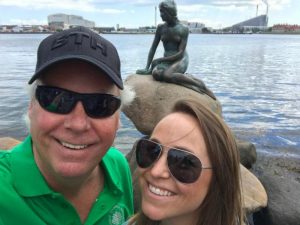
Ted and Skye
The Danes have done a spectacular job of greening their electricity systems and continue to work on decarbonizing mobility. All new car buyers in Denmark must pay a one-time 100% registration fee (doubling the cost of a car) and up to 130% for more expensive cars. Thus, the profusion of bikes including cargo bikes, flatbeds, and all sorts of child carrying bikes. Trains have ample room for bikes, there is bike parking everywhere. And no one has flashy bikes, they have small rear wheel locks only. Jorgen chuckles as I ask him about whether bikes are stolen. With so many of them, all rather basic and utilitarian, what’s to steal?
